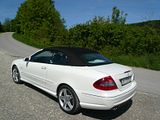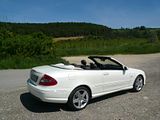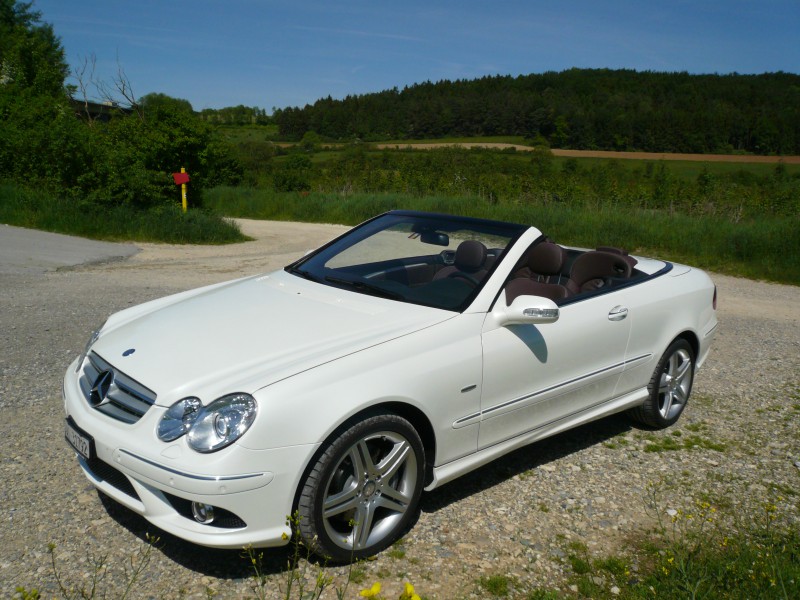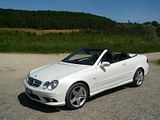

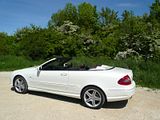
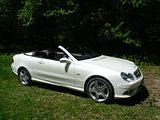 The Gods must have been shining on me this weekend. When I looked at the Swiss weather forecast, it appeared that there would be some nice sunny areas, so, in my quest for yet more variety from Mr Hertz’ Swiss fleet, I decided to book a convertible. No sooner was this done, than every successive forecast that I looked at was worse than the last. I had the horrid feeling that I was going to spend the 24 hour period with the roof up all the time. I duly arrived at the Zurich Airport Hertz desk, to be greeted by one of the regular staff who knows me well, who told me that he had a nice upgrade for me, as long as I was not planning on going to Italy. Luckily I was not, as the forecast suggested that the north east of Switzerland and southern Germany were going to be the best cabrio weather places, so I signed the extra disclaimer paperwork, and took delivery of a brand new, 134km on the clock, Mercedes CLK 280 Cabrio, in the rather imposing sounding “Grand Edition” finish.
The Gods must have been shining on me this weekend. When I looked at the Swiss weather forecast, it appeared that there would be some nice sunny areas, so, in my quest for yet more variety from Mr Hertz’ Swiss fleet, I decided to book a convertible. No sooner was this done, than every successive forecast that I looked at was worse than the last. I had the horrid feeling that I was going to spend the 24 hour period with the roof up all the time. I duly arrived at the Zurich Airport Hertz desk, to be greeted by one of the regular staff who knows me well, who told me that he had a nice upgrade for me, as long as I was not planning on going to Italy. Luckily I was not, as the forecast suggested that the north east of Switzerland and southern Germany were going to be the best cabrio weather places, so I signed the extra disclaimer paperwork, and took delivery of a brand new, 134km on the clock, Mercedes CLK 280 Cabrio, in the rather imposing sounding “Grand Edition” finish.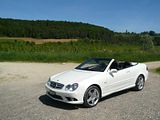 Very unusually for a Swiss rental car, when I went through to the parking garage, I found a white car waiting for me. Far better for photography than a black one, for sure, though I am not sure this would really be my preferred colour choice. Despite rather woeful forecasts still, the next morning, I woke to find a brilliant blue sky overhead, so I hastily packed up, and set off to enjoy the sunshine, fearful it would not last. In the end, the weather actually got better, and hotter (touching 30 degrees) until late afternoon, so I was able to enjoy open air motoring all day.
Very unusually for a Swiss rental car, when I went through to the parking garage, I found a white car waiting for me. Far better for photography than a black one, for sure, though I am not sure this would really be my preferred colour choice. Despite rather woeful forecasts still, the next morning, I woke to find a brilliant blue sky overhead, so I hastily packed up, and set off to enjoy the sunshine, fearful it would not last. In the end, the weather actually got better, and hotter (touching 30 degrees) until late afternoon, so I was able to enjoy open air motoring all day.
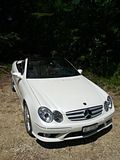
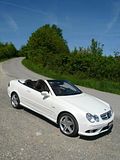
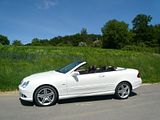 First task, then was to lower the roof. Simplicity itself. Provided the ignition is on, you simply press the button that is located on the transmission tunnel behind the gearlever, and hold it for the requisite length of time – I would estimate about 30 seconds or so. The mechanism is quite elaborate, first lowering all the side windows, then lifting the rear edge of the roof upwards. After this, the metal cover for the roof rises backwards, towards the rear of the car, them the whole roof retracts, and then the cover slides down again, leaving a very clean flat surface. Closing the roof is the exact reverse of this process. No catches to release, or secure. Simple.
First task, then was to lower the roof. Simplicity itself. Provided the ignition is on, you simply press the button that is located on the transmission tunnel behind the gearlever, and hold it for the requisite length of time – I would estimate about 30 seconds or so. The mechanism is quite elaborate, first lowering all the side windows, then lifting the rear edge of the roof upwards. After this, the metal cover for the roof rises backwards, towards the rear of the car, them the whole roof retracts, and then the cover slides down again, leaving a very clean flat surface. Closing the roof is the exact reverse of this process. No catches to release, or secure. Simple.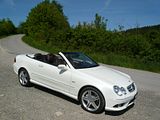 The downside, of course, is that the roof has to go somewhere, and that somewhere is in a large part of what would otherwise be the boot. When you open the boot lid, you get a small area that is the depth of the boot from top surface to floor, and a rather more shallow area that is under the roof area. Unlike in a hard top convertible, this area is permanently allocated to roof space, whether the roof is up or down. Prospective buyers of this would need to reassure themselves that they could live with the very small boot. That on the old Audi A4/S4 cabrio was certainly far larger. There is a bit more space under the boot floor, in the area where you should find a spare wheel, but you don’t, just the get you going foam. With some convertibles, especially those with a steeply raked windscreen, you have to be quite careful not to catch yourself in the unprotected top of the door pillar, but there were no real issues with the CLK.
The downside, of course, is that the roof has to go somewhere, and that somewhere is in a large part of what would otherwise be the boot. When you open the boot lid, you get a small area that is the depth of the boot from top surface to floor, and a rather more shallow area that is under the roof area. Unlike in a hard top convertible, this area is permanently allocated to roof space, whether the roof is up or down. Prospective buyers of this would need to reassure themselves that they could live with the very small boot. That on the old Audi A4/S4 cabrio was certainly far larger. There is a bit more space under the boot floor, in the area where you should find a spare wheel, but you don’t, just the get you going foam. With some convertibles, especially those with a steeply raked windscreen, you have to be quite careful not to catch yourself in the unprotected top of the door pillar, but there were no real issues with the CLK.
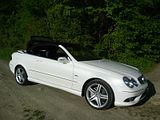


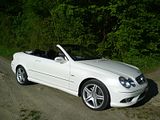
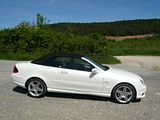
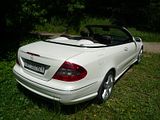 With the roof down – and there it stayed for all of the test, apart from taking a few pictures with it erected – time to get in and start the engine. A friend of mine – now emigrated to Australia – had an SLK 280 which shares an engine with this car, and the sound of that was mightily impressive. The CLK is more of a boulevard cruiser, so it is more muted, but nevertheless, there is a pleasant 6 cylinder rumble at idle. Don’t be fooled by the name, this car actually has a 3.0 litre engine, and it develops 231 bhp, which is adequate, but not going to make the car really fast. As a refined cruiser, though, it is indeed fine. Coupled with the standard 6 speed automatic gearbox, that does offer manual changes with column-mounted paddle shifts, this car is all about serene progress, but with the ability to shift a bit when the occasion demands. Perfectly happy to burble along at low revs, once you get past 3000 rpm, and push harder on the accelerator, the CLK 280 comes alive, and starts to rocket down the autobahn, until you remember that this is Switzerland, with its 120 km/h limit and rather too many cameras, with their zero tolerance policy.
With the roof down – and there it stayed for all of the test, apart from taking a few pictures with it erected – time to get in and start the engine. A friend of mine – now emigrated to Australia – had an SLK 280 which shares an engine with this car, and the sound of that was mightily impressive. The CLK is more of a boulevard cruiser, so it is more muted, but nevertheless, there is a pleasant 6 cylinder rumble at idle. Don’t be fooled by the name, this car actually has a 3.0 litre engine, and it develops 231 bhp, which is adequate, but not going to make the car really fast. As a refined cruiser, though, it is indeed fine. Coupled with the standard 6 speed automatic gearbox, that does offer manual changes with column-mounted paddle shifts, this car is all about serene progress, but with the ability to shift a bit when the occasion demands. Perfectly happy to burble along at low revs, once you get past 3000 rpm, and push harder on the accelerator, the CLK 280 comes alive, and starts to rocket down the autobahn, until you remember that this is Switzerland, with its 120 km/h limit and rather too many cameras, with their zero tolerance policy.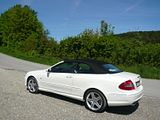 I did not drive many German autobahn miles and there was too much traffic to see what the car could really do. Even accepting that I drove the car quite gently, and the air conditioning was switched off, but I did have the roof down all day, the overall fuel consumption at 31 mpg seems perfectly reasonable to me. The CLK is quite a big car, but it does not feel so when driving it. Part of this feeling must come from the excellent visibility that you have when the roof is lowered, but also because the steering is light. It has just enough feel, but certainly would never pass the Parry-Jones Ford test. The same could be said for the handling, which was predictable enough, meaning the Cabrio could be taken around swooping autobahn curves and junctions with no worries, but this is not really a car that you would want to push to the limit, just for the sake of it. There was not much evidence of the fact that this a car with its roof cut off, with no rattles (it was brand new, let’s face it), and only a slight hint of scuttle shake. The brakes were light, and effective, and are backed up by a traditional foot operating parking brake, which is released with a large release lever mounted on the dash, below the switch for the lights. As such systems go, it works OK, and as the car is an automatic, there is less call for the parking brake anyway.
I did not drive many German autobahn miles and there was too much traffic to see what the car could really do. Even accepting that I drove the car quite gently, and the air conditioning was switched off, but I did have the roof down all day, the overall fuel consumption at 31 mpg seems perfectly reasonable to me. The CLK is quite a big car, but it does not feel so when driving it. Part of this feeling must come from the excellent visibility that you have when the roof is lowered, but also because the steering is light. It has just enough feel, but certainly would never pass the Parry-Jones Ford test. The same could be said for the handling, which was predictable enough, meaning the Cabrio could be taken around swooping autobahn curves and junctions with no worries, but this is not really a car that you would want to push to the limit, just for the sake of it. There was not much evidence of the fact that this a car with its roof cut off, with no rattles (it was brand new, let’s face it), and only a slight hint of scuttle shake. The brakes were light, and effective, and are backed up by a traditional foot operating parking brake, which is released with a large release lever mounted on the dash, below the switch for the lights. As such systems go, it works OK, and as the car is an automatic, there is less call for the parking brake anyway.
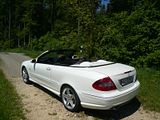
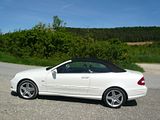
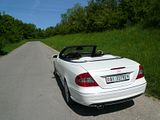
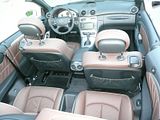 If this car’s raison d’etre is more about boulevard cruising, then it needs to impress inside. And, by and large it does. The test car, in Grand Edition spec, came with soft feeling leather seats that were finished in dark brown leather, with a black base to them. The leather trims on the doors were completed by further dark brown coverings, all in a slightly rouched effect. Perhaps not my choice of colours, but there was little doubting the quality of the leather and the sense of luxury that it imparted. The main dash moulding was black, formed from good quality, though not that soft a plastic, with a different almost woven covering on the lower surfaces. Fit and finish was very good, though I did wonder about the longevity of a few items, as the driver’s foot rest was quickly rather dirty just from grit from the sole of my left shoe.
If this car’s raison d’etre is more about boulevard cruising, then it needs to impress inside. And, by and large it does. The test car, in Grand Edition spec, came with soft feeling leather seats that were finished in dark brown leather, with a black base to them. The leather trims on the doors were completed by further dark brown coverings, all in a slightly rouched effect. Perhaps not my choice of colours, but there was little doubting the quality of the leather and the sense of luxury that it imparted. The main dash moulding was black, formed from good quality, though not that soft a plastic, with a different almost woven covering on the lower surfaces. Fit and finish was very good, though I did wonder about the longevity of a few items, as the driver’s foot rest was quickly rather dirty just from grit from the sole of my left shoe.
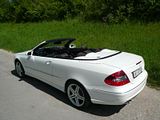
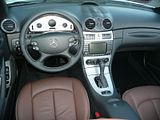 The dash comprises a binnacle with just three main instruments, and two bar charts on either side, for fuel level and water temperature, and a number of warning lights in the centre, and around the lower peripheries of the dials. The overall effect is simple and relatively unfussy. A comprehensive audio system is the main element of the centre console, and it proved easy to use, and still audible when the roof was down, without needing to turn up the volume to distortion levels. Below this are the climate control switches, and above it a row of other switches, such as those to enable/disable the parking sensors and heated seats comprise the main switchgear. The lights, with an auto sensor that was useful for tunnels, are controlled by a switch to the left of the column. As ever with Mercedes, a large left hand mounted column controls indicators and wiper functions, and a smaller, more spindly stalk above is for the cruise control. I found it less easy to get the wrong stalk here than in some Mercedes I have tested.
The dash comprises a binnacle with just three main instruments, and two bar charts on either side, for fuel level and water temperature, and a number of warning lights in the centre, and around the lower peripheries of the dials. The overall effect is simple and relatively unfussy. A comprehensive audio system is the main element of the centre console, and it proved easy to use, and still audible when the roof was down, without needing to turn up the volume to distortion levels. Below this are the climate control switches, and above it a row of other switches, such as those to enable/disable the parking sensors and heated seats comprise the main switchgear. The lights, with an auto sensor that was useful for tunnels, are controlled by a switch to the left of the column. As ever with Mercedes, a large left hand mounted column controls indicators and wiper functions, and a smaller, more spindly stalk above is for the cruise control. I found it less easy to get the wrong stalk here than in some Mercedes I have tested.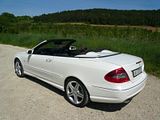 Final mention has to be made of the distance sensor display at the top of the middle of the dash, which is also matched by a similar display between the two rear seats, which showed in simple graphical form proximity to objects when manoeuvering. I did not find it particularly helpful, and it was in any case accompanied by beeping. Visibility with the roof raised is far less challenging than in many cabrios, with good sized rear side windows and a generously proportioned glass rear window. The heating element in this quickly removed the early morning condensation that greeted me.
Final mention has to be made of the distance sensor display at the top of the middle of the dash, which is also matched by a similar display between the two rear seats, which showed in simple graphical form proximity to objects when manoeuvering. I did not find it particularly helpful, and it was in any case accompanied by beeping. Visibility with the roof raised is far less challenging than in many cabrios, with good sized rear side windows and a generously proportioned glass rear window. The heating element in this quickly removed the early morning condensation that greeted me.
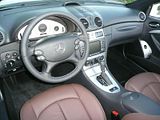
 This is a four seater cabrio. With two separate bucket seats in the rear, and a recessed storage well between the seats, you simply would not try to put a fifth person in the CLK. Rear legroom looked adequate, rather than generous, but unlike the smaller cabrios, adults definitely would fit in here. They have the benefit of a fold down armrest between the seats, their own rear window controls and retractable headrests that’s about it. Otherwise, equipment levels on this special edition car seemed reasonable. Having used the door mounted electric controls to adjust the height, reach and angle of the driver’s seat, and noted the 3 setting memory, I was surprised to find that the passenger seat had a manual adjustment with the long upwards curved bar at one corner of the seat.
This is a four seater cabrio. With two separate bucket seats in the rear, and a recessed storage well between the seats, you simply would not try to put a fifth person in the CLK. Rear legroom looked adequate, rather than generous, but unlike the smaller cabrios, adults definitely would fit in here. They have the benefit of a fold down armrest between the seats, their own rear window controls and retractable headrests that’s about it. Otherwise, equipment levels on this special edition car seemed reasonable. Having used the door mounted electric controls to adjust the height, reach and angle of the driver’s seat, and noted the 3 setting memory, I was surprised to find that the passenger seat had a manual adjustment with the long upwards curved bar at one corner of the seat.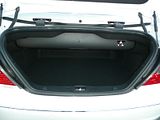 Other items of note included electrically heated front seats, a remote boot release from the door mounted switch, as well as the audio system, climate control and all round parking sensors. A neat feature is that when you turn on the ignition, a motor powers the retracted seat belt forward to make it easier for you to grasp the buckle and pull it forward over your torso. That will certainly save people putting their shoulder out of joint, reaching around and backwards. In keeping with the touring theme, there is a large lockable cubby between the seats, with a shallow top tray and a deeper holder underneath, and the glove box is a reasonable size, though not large enough for the bulky handbook, which was jammed in the passenger door pocket, and there are elasticated pockets on the back of the front seats. Oddly, there did not seem to be any sign of cup-holders!
Other items of note included electrically heated front seats, a remote boot release from the door mounted switch, as well as the audio system, climate control and all round parking sensors. A neat feature is that when you turn on the ignition, a motor powers the retracted seat belt forward to make it easier for you to grasp the buckle and pull it forward over your torso. That will certainly save people putting their shoulder out of joint, reaching around and backwards. In keeping with the touring theme, there is a large lockable cubby between the seats, with a shallow top tray and a deeper holder underneath, and the glove box is a reasonable size, though not large enough for the bulky handbook, which was jammed in the passenger door pocket, and there are elasticated pockets on the back of the front seats. Oddly, there did not seem to be any sign of cup-holders!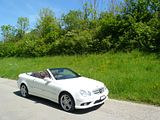
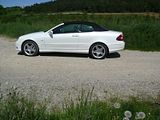
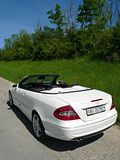 Ignoring the very personal factors of colour and detailed trim, I did enjoy driving this car. I tried to answer the question whether it was simply that it was a convertible, and since I had such nice weather, it was “convertibleness” that made me sad to hand it back in on Sunday evening. I think it was more than that. It’s not a sports car, for sure, but as a cruiser, it is rather enjoyable. The CLK Cabrio feels special. It goes well enough, and the engine sounds good while it does it. Four people, with limited luggage, could happily motor down to warmer climes, like the Med in this car, and they’d all enjoy it, even the driver. However, it does not have the market to itself, and the imminent launch of the Infiniti G37 and Lexus IS-C will double the number of competitors, which really number 2 at present. I’ve not driven the 3 Series Cabrio, but I did test the old model Audi S4 Cabrio. That car had everything that the Mercedes has, and to my mind looks even better. The new A5/S5 Cabrio looks just as good and looks like it will be a formidable alternative. Whilst I hope to find the opportunity soon to see if it would get my vote or not, I have to conclude that anyone who picked the Mercedes is unlikely to be disappointed. And if Mr Hertz would like to offer me one of these cars again, I will very politely grab the keys before he changes his mind.
Ignoring the very personal factors of colour and detailed trim, I did enjoy driving this car. I tried to answer the question whether it was simply that it was a convertible, and since I had such nice weather, it was “convertibleness” that made me sad to hand it back in on Sunday evening. I think it was more than that. It’s not a sports car, for sure, but as a cruiser, it is rather enjoyable. The CLK Cabrio feels special. It goes well enough, and the engine sounds good while it does it. Four people, with limited luggage, could happily motor down to warmer climes, like the Med in this car, and they’d all enjoy it, even the driver. However, it does not have the market to itself, and the imminent launch of the Infiniti G37 and Lexus IS-C will double the number of competitors, which really number 2 at present. I’ve not driven the 3 Series Cabrio, but I did test the old model Audi S4 Cabrio. That car had everything that the Mercedes has, and to my mind looks even better. The new A5/S5 Cabrio looks just as good and looks like it will be a formidable alternative. Whilst I hope to find the opportunity soon to see if it would get my vote or not, I have to conclude that anyone who picked the Mercedes is unlikely to be disappointed. And if Mr Hertz would like to offer me one of these cars again, I will very politely grab the keys before he changes his mind.